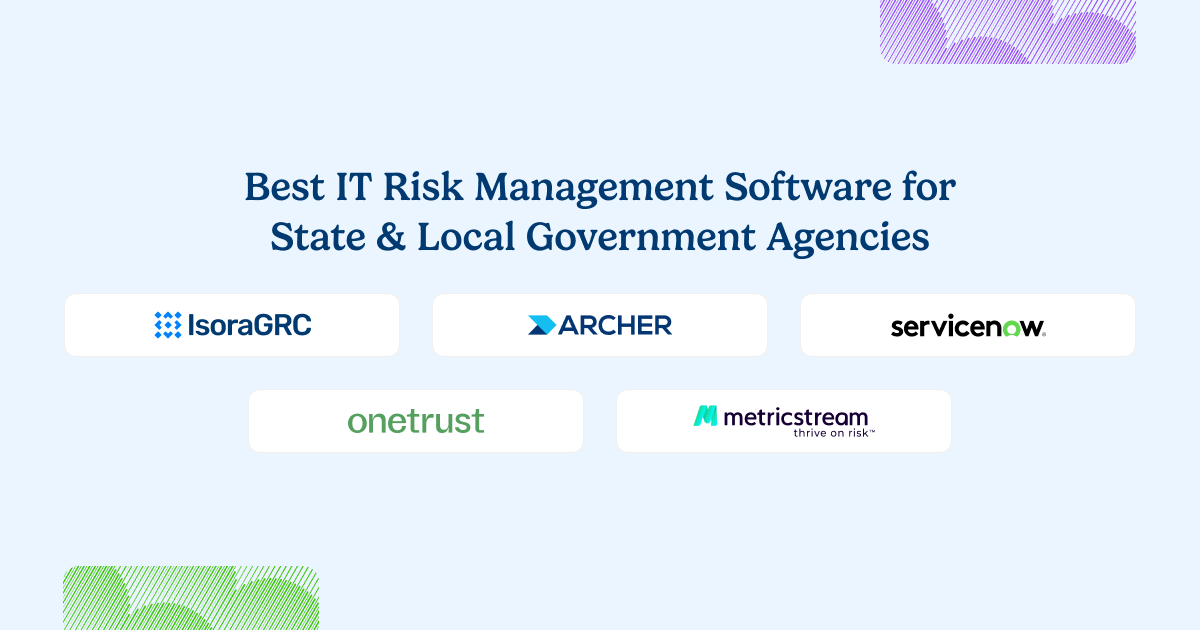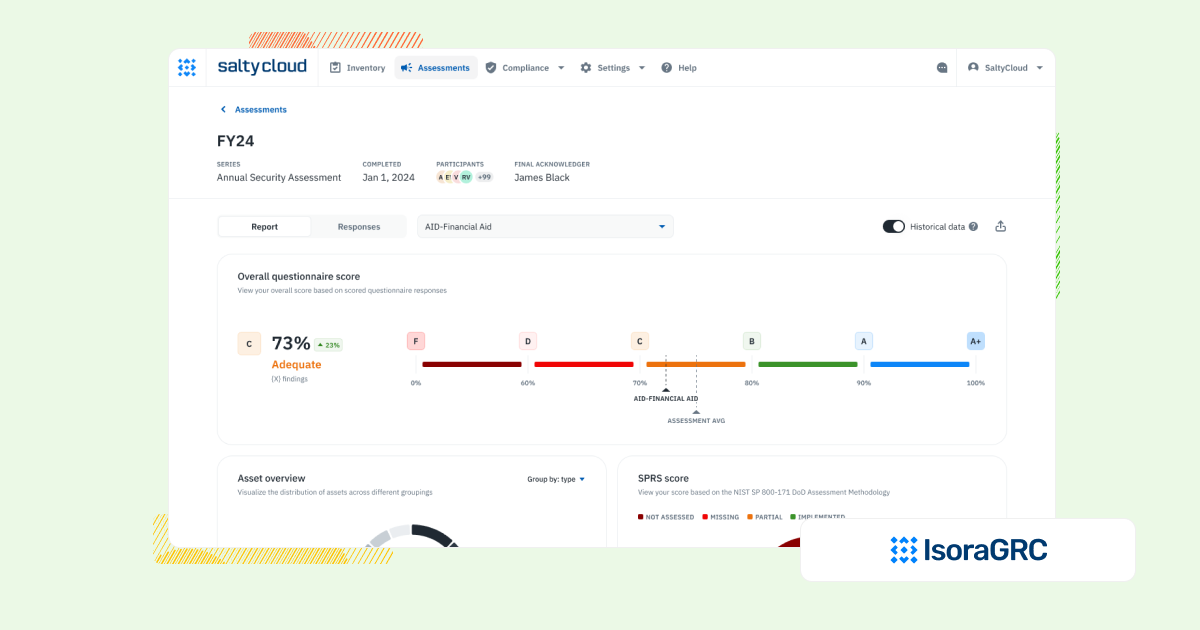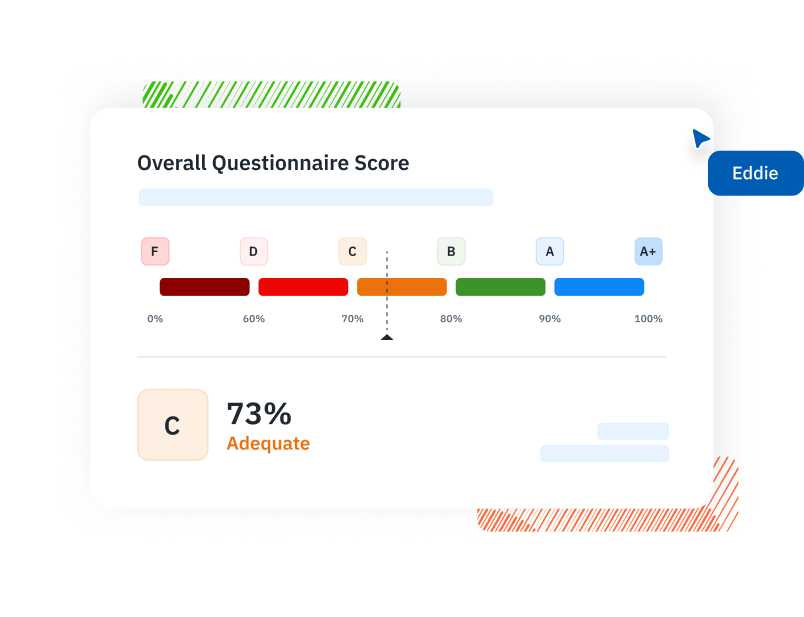
State and local government agencies face stringent cybersecurity requirements, complex regulatory environments, and the necessity for structured IT risk management practices. Agencies need tools designed specifically for the public sector that streamline security risk assessments, automate compliance processes (including NIST 800-53), and provide robust management for decentralized IT asset inventories and third-party vendor risks.
This guide reviews the best IT risk management software for state and local governments, focusing on solutions that meet rigorous security standards, simplify vendor management, and optimize compliance reporting.
What to Look For in IT Risk Management Software for Public Sector Agencies
| Workflow Capability | Why It Matters for State & Local Government |
| Assessment Management | Automates structured security risk assessments aligned with NIST 800-53 and simplifies compliance documentation required by state and federal audits. |
| Questionnaire Delivery & Completion | Streamlines delivery and completion of security questionnaires, ensuring efficient vendor assessments and internal data gathering across agency business units. |
| Inventory Tracking | Provides a centralized, accurate inventory of IT assets, applications, and vendors—crucial for managing cybersecurity risks in complex governmental IT environments. |
| Risk Register & Exception Management | Enables systematic tracking, prioritization, and remediation of IT risks and compliance exceptions, helping agencies maintain consistent regulatory adherence. |
| Scoring, Reporting & Risk Visualization | Offers clear, actionable reporting and risk visualization capabilities, facilitating effective communication to internal stakeholders and external regulatory auditors. |
| Collaboration & User Experience | Ensures intuitive user experience and cross-department collaboration—crucial for effective risk management within public-sector organizations. |
| Implementation & Setup | Rapid implementation and low administrative overhead—allowing government teams to quickly achieve value without heavy reliance on external consultants or extensive training. |
The Top 5 Best IT Risk Management Tools for Public Sector Agencies in 2025
1. Isora GRC

| Category | Details |
| Best For | Security teams at state & local government agencies who need a streamlined, scalable IT risk management platform for public sector compliance requirements. |
| Overview | Isora GRC is the GRC Assessment Platform™ built specifically for information security teams. Isora GRC empowers public sector agencies to efficiently manage IT risk, compliance, and vendor oversight. Designed to meet rigorous standards like NIST 800-53, it provides intuitive security assessments, centralized asset inventories, and vendor risk management—simplifying complex processes for busy government teams. |
| Strengths | Built for workflows, not checklists
✅ Supports assessments, inventory tracking, risk registers, and exceptions in a unified experience. Designed for org-wide adoption ✅ WCAG-compliant UX that requires no training and makes risk everyone’s job. Fast time-to-value ✅ Live in days or weeks, with no-code setup and minimal lift from IT. Flexible by default ✅ Customizable assessments, scalable categories, and framework mapping without heavy configuration. Scales across teams and vendors ✅ Works equally well for internal teams and third-party risk management programs. |
| Limitations | ⚠️ Not designed for legal, audit, or finance teams seeking one platform for enterprise-wide GRC
⚠️ May be too structured for teams looking to build one-off surveys or lightweight audits without repeatable workflows |
| When to Consider | Ideal for state and local government security reams that want to move beyond spreadsheets or outdated GRC platforms toward structured, easy-to-use, collaborative IT risk management aligned to regulatory frameworks. |

2. Archer IRM
| Category | Details |
| Best For | Large government agencies with centralized governance structures and the staffing to manage a complex, high-maintenance GRC platform. |
| Overview | Archer IRM is a powerful but complex enterprise GRC solution. While it can be configured to meet public sector requirements like NIST 800-53, it typically requires extensive IT support, outside consultants, and long timelines, making it a heavy lift for state and local teams seeking agility. |
| Strengths | ✅ Robust governance and risk tracking tools for organizations managing multiple compliance mandates like NIST, FISMA, or FedRAMP
✅ Customizable workflows and reporting options to align with public sector IT risk and compliance software needs |
| Limitations | ⚠️ High cost and long implementation cycles, often needing dedicated GRC specialists and external services
⚠️ Lacks the simplicity and flexibility needed for distributed teams or lean IT departments in state agencies |
| When to Consider | If your agency needs a deeply customizable IT GRC tool for public sector oversight, but can work around slow setup and high resource requirements to operate and maintain it effectively. |
| Other Comparisons | Archer IRM vs ServiceNow GRC vs Isora GRC
LogicGate vs Archer IRM vs Isora GRC ZenGRC vs Archer IRM vs Isora GRC |
3. ServiceNow GRC
| Category | Details |
| Best For | Public sector agencies already using ServiceNow and seeking to add risk and compliance workflows into their existing IT infrastructure. |
| Overview | ServiceNow GRC integrates risk, compliance, and IT operations in one system. While it offers powerful features for IT governance, it’s best suited for teams already deep in the ServiceNow ecosystem. Setup and configuration often require significant time and technical skill. |
| Strengths | ✅ Strong integration with ITSM and IT operations tools, useful for system-level IT risk assessments and incident response
✅ Can support NIST 800-53 and other public sector frameworks when properly configured |
| Limitations | ⚠️ High learning curve and cost, especially for smaller state or local agencies with limited technical resources
⚠️ Customization and automation often require external support or advanced internal expertise |
| When to Consider | If your government agency already uses ServiceNow and wants to extend it for IT risk assessments, but can manage the complexity and setup burden of adapting it for cybersecurity compliance in the public sector |
| Other Comparisons | Archer IRM vs ServiceNow GRC vs Isora GRC
OneTrust vs ServiceNow GRC vs Isora GRC |
4. OneTrust
| Category | Details |
| Best For | Public sector teams focused on privacy, vendor compliance, and data governance more than hands-on IT risk tracking or assessments. |
| Overview | OneTrust is excellent in privacy and third-party compliance, offering tools to support data protection and vendor risk. While it supports public sector regulations, it’s less suited for teams that need flexible IT risk assessments, system-level inventories, or fast-moving security workflows. |
| Strengths | ✅ Strong for managing privacy laws, third-party vendor compliance, and security questionnaires
✅ Can help support GLBA and cybersecurity compliance for public sector audits when paired with other tools |
| Limitations | ⚠️ Limited flexibility for internal IT system and application security assessments or IT asset tracking
⚠️ May feel overly complex or fragmented for small to mid-sized agencies needing quick, unified workflows |
| When to Consider | If your agency is focused on vendor oversight or data privacy programs, but can work around limited IT risk and asset assessment capabilities for broader cybersecurity compliance needs. |
| Other Comparisons | OneTrust vs ServiceNow GRC vs Isora GRC |
5. MetricStream
| Category | Details |
| Best For | Large state or multi-agency organizations that need to unify governance, risk, and compliance across departments. |
| Overview | MetricStream is a heavyweight GRC platform often used in federal and large enterprise environments. It supports complex regulatory frameworks like NIST 800-53, but it’s rarely ideal for smaller or decentralized public sector teams due to long setup times and the need for ongoing technical support. |
| Strengths | ✅ Designed to handle large-scale IT risk and compliance software requirements for state agencies and federal programs
✅ Supports a wide array of regulatory frameworks and controls, including NIST, FedRAMP, and GLBA Safeguards Rule |
| Limitations | ⚠️ Long implementation cycles and high complexity make it less practical for lean or decentralized agencies
⚠️ Not built for agile security assessments, IT asset inventories, or collaboration across departments without customization |
| When to Consider | If your agency has complex oversight needs across many departments, and can commit the resources and expertise to configure and maintain a large public sector IT GRC tool |
| Other Comparisons | MetricStream vs SAP GRC vs Isora GRC |
What Our Customers Say About Isora GRC
Security teams at top institutions are using Isora GRC to replace legacy tools and manual processes with intuitive workflows and actionable insight.
“Moving from manual processes to using Isora was a breath of fresh air. What used to take months is now automated, reliable, and defensible. Isora saves us significant time while delivering accurate insights that improve decision-making.”
Jessica Sandy, IT GRC Manager, The University of Chicago
“Isora has been essential in helping us meet our University of California cybersecurity requirements across a decentralized campus. Automating assessment data collection and reporting has given us clear visibility into unit-level risks, enabling us to prioritize resources effectively and address gaps with confidence.”
Allison Henry, CISO, The University of California, Berkeley
FAQs
What is the best IT GRC tool for state and local government agencies to manage cybersecurity compliance?
The best tool for state and local government agencies is one that simplifies compliance with standards such as NIST 800-53, streamlines security risk assessments, automates questionnaire management, and centralizes IT asset tracking. Isora GRC is specifically built to fulfill these public-sector needs efficiently and intuitively.
How do state and local government agencies effectively perform NIST 800-53 security assessments?
Agencies perform effective NIST 800-53 security assessments by using specialized IT risk platforms like Isora GRC. These platforms automate assessment processes, deliver and track security questionnaires efficiently, and simplify evidence collection, ensuring smooth audits and consistent compliance.
What’s the difference between general compliance software and specialized IT risk software for public sector agencies?
Specialized IT risk software, like Isora GRC, is explicitly designed to handle technical cybersecurity compliance (e.g., NIST 800-53) and related workflows (asset inventories, risk registers, third-party assessments). General compliance software typically addresses broader compliance needs without structured IT-specific capabilities required by state and local agencies.
Why is centralized IT asset inventory management essential for state and local governments?
Centralized IT asset inventory management provides critical visibility into IT systems, applications, and vendor dependencies. Platforms like Isora GRC help government agencies track, assess, and manage IT risks effectively—essential for maintaining cybersecurity and regulatory compliance across departments.
How can public sector agencies streamline third-party vendor risk management?
State and local agencies streamline vendor risk management by using specialized IT risk tools like Isora GRC. These tools simplify security questionnaire distribution, automate assessment workflows, and track third-party risks centrally, helping agencies maintain compliance and manage cybersecurity risks more effectively
What features should state and local agencies look for in IT risk management software?
Agencies should prioritize structured security assessments (NIST 800-53), intuitive collaboration, centralized asset tracking, effective risk and exception management, and efficient third-party vendor risk oversight—key capabilities integrated into purpose-built public sector tools like Isora GRC.
How do IT risk management platforms help state and local government agencies prepare for regulatory audits?
Platforms like Isora GRC help agencies automate assessment workflows, simplify security questionnaire completion, centralize risk documentation, and streamline evidence collection. This structure significantly reduces audit prep time and ensures continuous compliance with NIST 800-53 and other governmental cybersecurity standards.


















